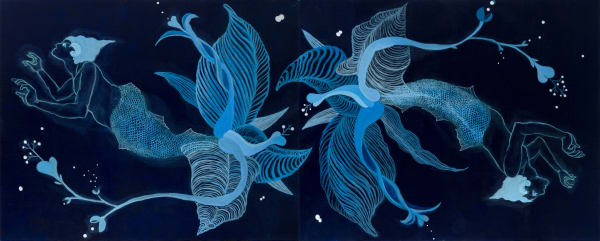-

Come With Me, 2019, Acrylic, linen, wooden panel, 154 x 110 cm
-

Detail of Praying for Good Luck, 2017, acrylic, linen, wood panel, 45.2 x 25.7 cm
-

Luminous Bones, 2022, Acrylic, pastel, photoluminescent powder, wood panel 181.8 x 227.3 cm
-
I started painting the figure's skin with a smooth white surface due to the influence from modern Bijin-ga paintings. The beauty of limbs on a white matte surface rimmed with a thin line of gray and pale red atop a natural ground color – these color sensations and textures that cause one to remember the tactility just by looking – I appreciated them and stared at them as closely as possible. That first visual experience remained vividly in my aesthetic sense. I like seeing what I think is a ‘beautiful person’ (existing in reality), but the figures that I paint do not exist in flesh and blood. The beauty of a person I depict starts from a pictorial beauty (an attempt to reproduce it), not from the result of trying to reproduce a real person. Fundamentally, it begins with "an adoration of that beautiful Bijin-ga painting", so I place the tone of the skin color relatively light, and then adjust it in relation to and within the range of the colors of the base, background and other motifs. In the case where I am conscious that it is a self-portrait, it brings a big change to the overall color tone of the painting. The fixed dark yellowish skin color is a limitation to the color composition. This dark yellowish skin color is close to the natural ground color and the wooden tone that I like to paint, so it becomes necessary to change the motif itself or match the ground color and background with this dark yellowish skin color. However, I would rather accept these changes than to have the figure in the painting be distant from my mental state. My painting changes through the conflict between the escape from adoration and imitation, and the faithfulness to my own aesthetics. Moreover, just as how I could suddenly draw trousers, I may be able to paint things that I previously did not want to. Perhaps, there may be a way to shorten the mental distance between the figure and myself by eliminating humanity in a more extreme direction.
Unless I let go of the figure in the painting, I think the painting will change in response to myself. The tension between not renouncing the figure as "different from myself", trying to be a self-portrait, and being happy with what I have painted, are all important. I always want to be one with a painting and its part in that way.
-
Related Exhibition
Ota Fine Arts 7CHOME -
List of works
-
 BuBu de la MadeleineGender Queer Dance, 2023Acrylic and pastel on canvas80.3 x 200 cm (set of two, 80.3 x 100 cm each)
BuBu de la MadeleineGender Queer Dance, 2023Acrylic and pastel on canvas80.3 x 200 cm (set of two, 80.3 x 100 cm each) -
 Nobuaki TakekawaF**K OFF TRANSPHOBES, 2023Acrylic on canvas (set of two)130.3 x 194 cm
Nobuaki TakekawaF**K OFF TRANSPHOBES, 2023Acrylic on canvas (set of two)130.3 x 194 cm
51 1/4 x 76 3/8 in -
 Tomoko KashikiCome With Me, 2019Acrylic, linen, wooden panel154 x 110 cm
Tomoko KashikiCome With Me, 2019Acrylic, linen, wooden panel154 x 110 cm -
 Nobuaki TakekawaLady Scorpius, 2016Mixed mediaH191 x 80 x 70 cm
Nobuaki TakekawaLady Scorpius, 2016Mixed mediaH191 x 80 x 70 cm
-
Past viewing_room












